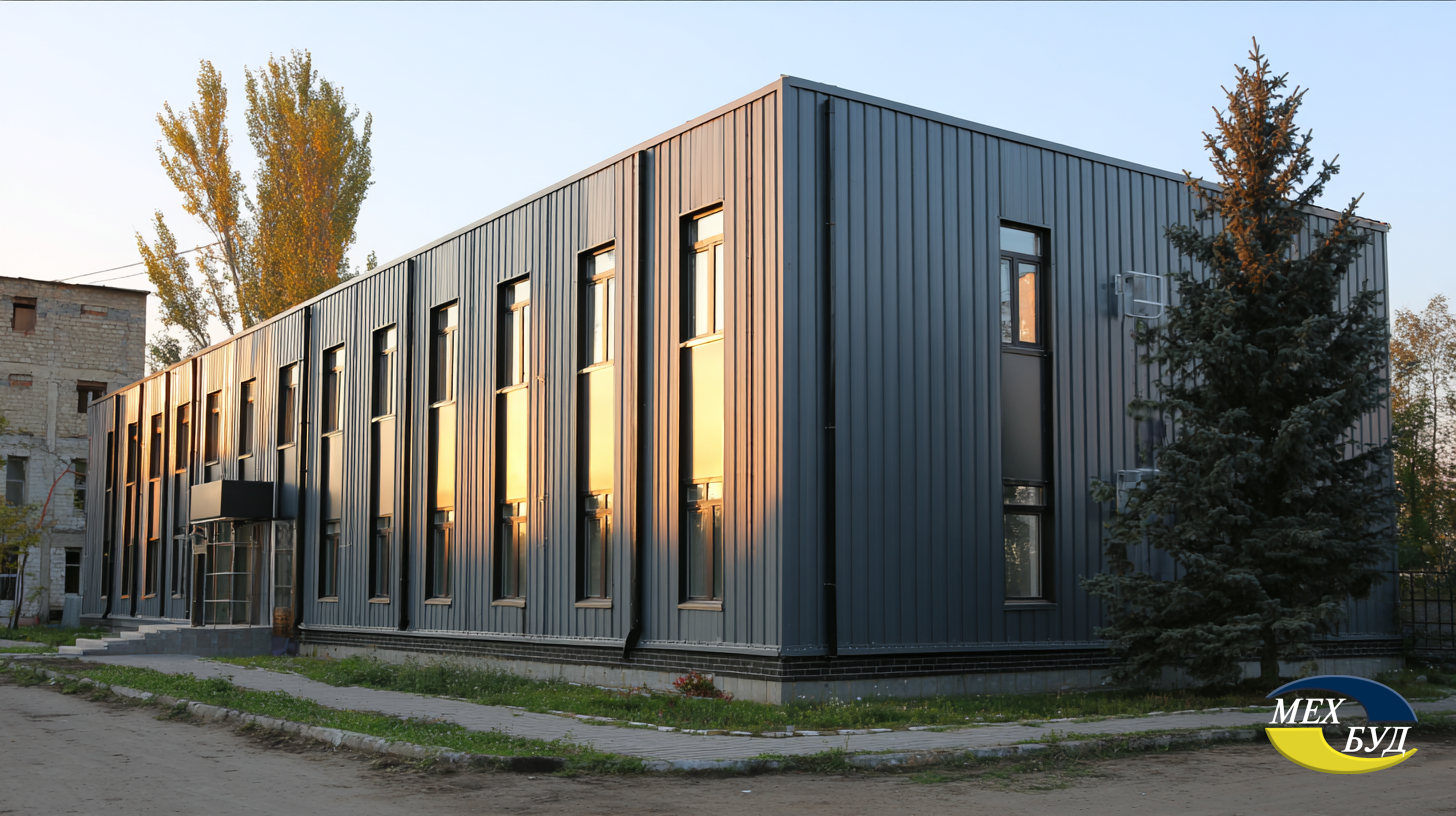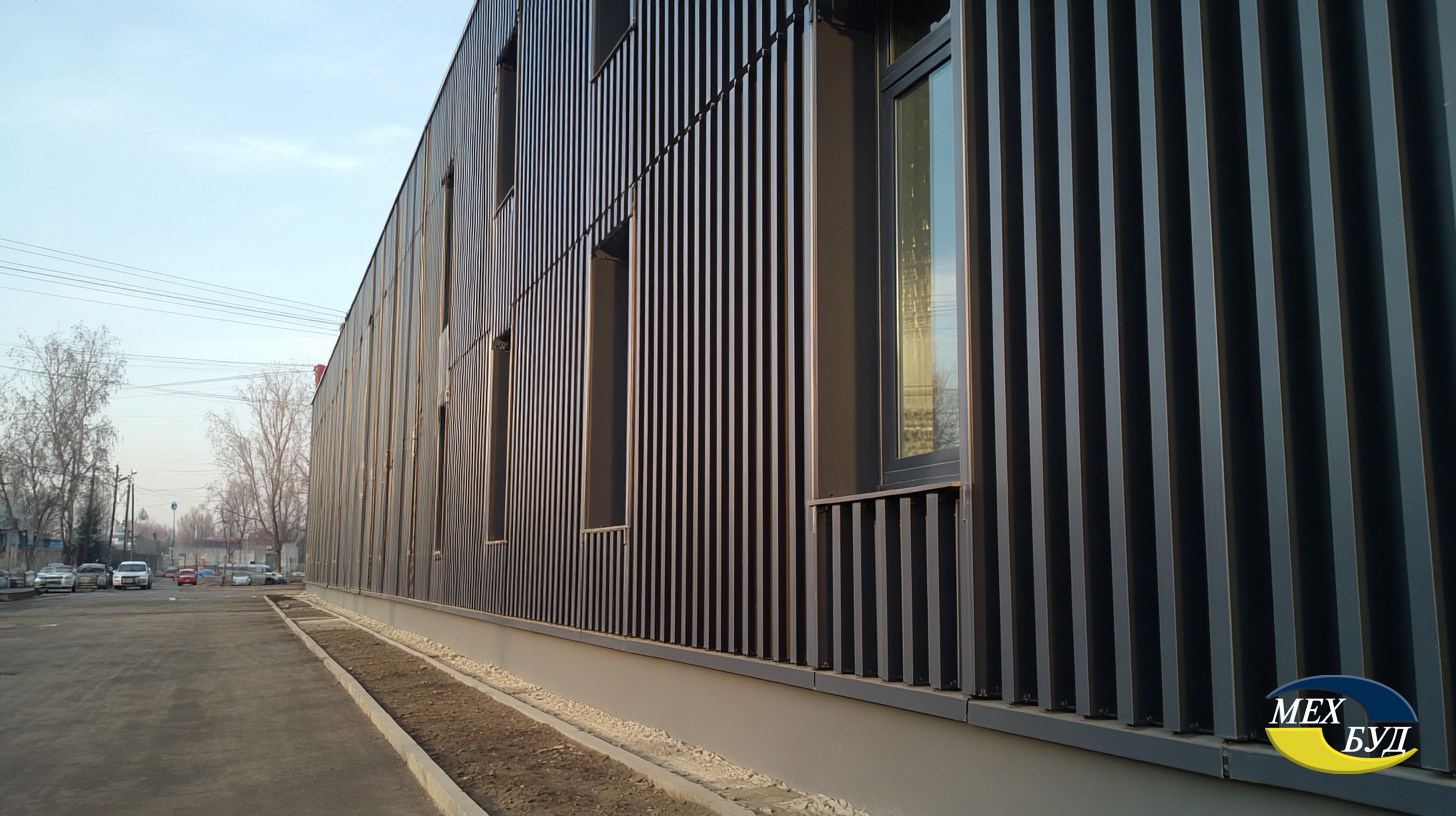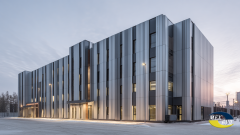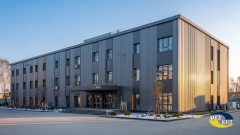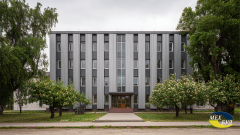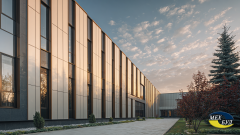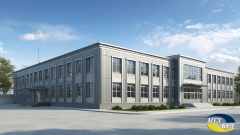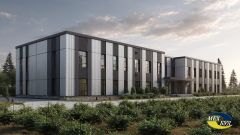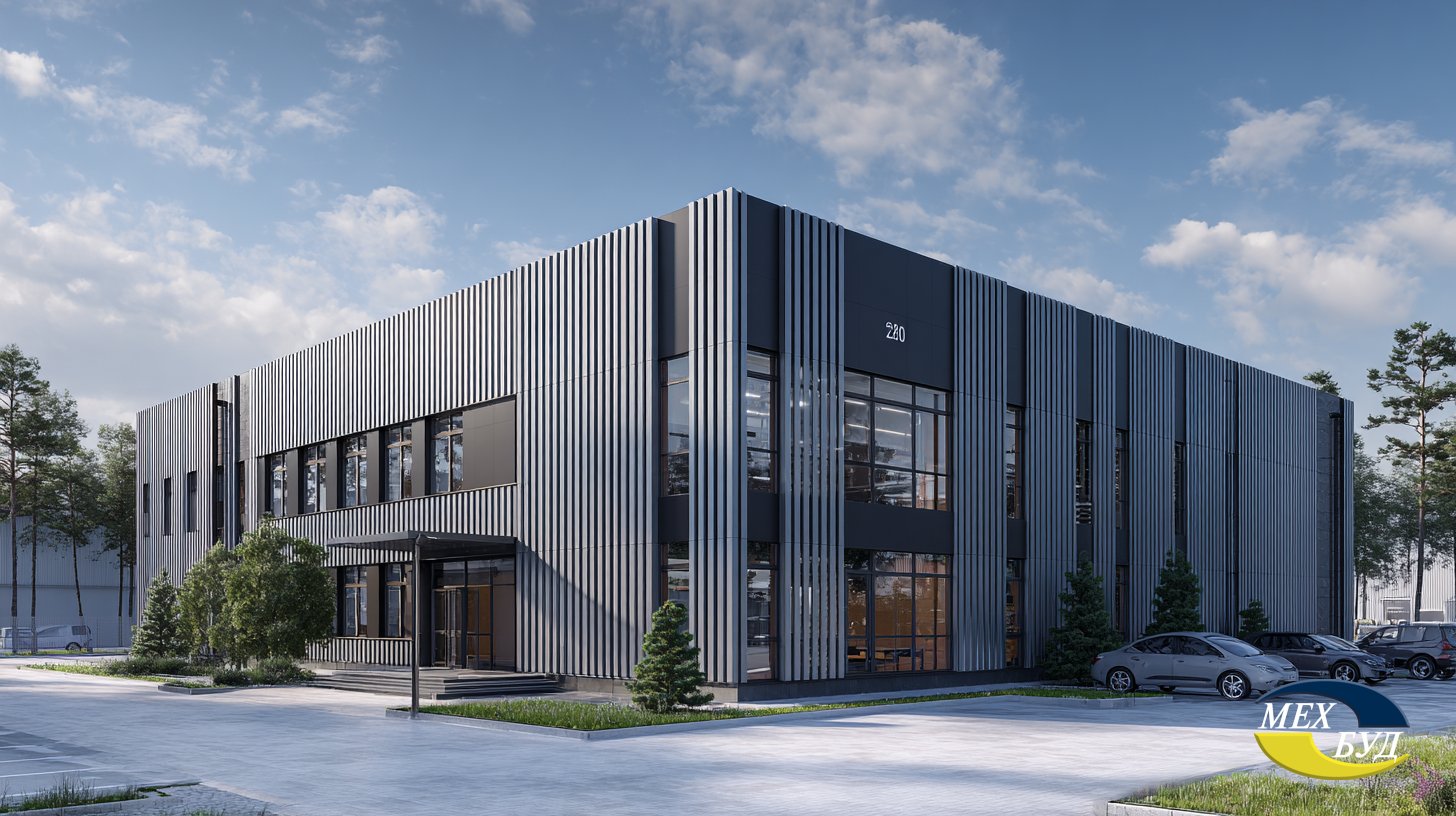Benefits of Metal Facades for Commercial Buildings
Beyond their visual impact, modern metal facades deliver a range of practical benefits that are especially valuable for commercial and administrative buildings. These advantages — from longevity and weather resistance to energy savings — explain why metal cladding has become a go-to solution in contemporary architecture. Below, we break down some key benefits and how they apply in the context of offices and public facilities:
Durability and Weather Resistance
One of the greatest advantages of metal facades is their exceptional durability in challenging climates. Properly coated steel or aluminum panels can easily withstand decades of exposure with minimal upkeep. Hot-dip galvanized steel, which is commonly used as the base for facade panels, has proven longevity even in harsh environments. Studies show galvanized coatings corrode at only about 1/30th the rate of uncoated steel, meaning a well-made metal facade can go many decades before requiring significant maintenance. Industry data indicate that thick zinc galvanizing can protect steel for 70+ years even under industrial pollution or marine conditions.
In Ukraine, where building exteriors must endure freeze-thaw cycles, heavy snow, and strong summer UV, this resilience is a major asset. Galvanized and polymer-coated sheet metal resists rust far better than ordinary painted plaster or concrete, preventing the kind of deterioration (peeling, cracking, staining) that plagues older façades over time.
Manufacturers back these longevity claims with concrete performance specs. Mehbud, for instance, highlights that each panel in its systems is made from zinc-coated steel with a durable powder or PVDF (polyvinylidene fluoride) finish, making it “less prone to aging” than bare metal alternatives. The company’s quality standards ensure minimum lifespans: powder-coated panels are rated for ~15 years of finish durability, PVDF-coated panels for ~20 years, and the overall corrosion protection of the galvanized steel core extends 30+ years before any major refurbishment might be needed.
This kind of long-term performance is a huge benefit for commercial property owners, as a metal-clad facade will retain its integrity and appearance far longer than most traditional cladding materials. Critically, it’s also low-maintenance — periodic washing is usually sufficient, and if a section is damaged, individual panels can be replaced without overhauling the entire facade. In short, a well-engineered metal facade provides a rugged shield against weathering, giving office buildings and public facilities a reliable envelope that protects the interior for generations.
Thermal Efficiency and Energy Savings
Modern sheet metal facades do more than just protect a building; they also significantly improve its thermal performance. Most contemporary metal facades in commercial use are ventilated rainscreens combined with insulation, which markedly boosts energy efficiency. The concept is that the air cavity and insulation layer behind the metal panels act as a thermal buffer for the building. According to facade industry sources, a properly installed ventilated cladding system can cut a building’s heating and cooling energy demands by roughly 25-30%.
This happens in several ways. First, the ventilated air gap prevents direct heat transfer: in summer the gap dissipates solar heat before it reaches the structural wall, and in winter it helps retain warmth by reducing thermal bridging. Second, insulation (often mineral wool or rigid foam boards) is placed behind the metal panels, adding R-value to what might have been an uninsulated masonry or concrete wall. The result is more stable indoor temperatures — warmer interiors in winter and cooler interiors in summer, with less reliance on HVAC systems.
For office workers and equipment, this thermal stability is important for comfort and operations. And for the building owner, it means lower utility bills. Mehbud notes that its ventilated metal façade systems “improve thermal insulation of a structure, resulting in energy savings by preserving warmth in winter and coolness in summer.” Indeed, once a facade retrofit is done, facility managers often observe a noticeable drop in heating costs and a reduced load on air conditioning. Over the life of the facade, those savings accumulate, effectively helping the upgrade pay for itself.
Given rising energy prices and Ukraine’s push for greater energy efficiency (aligned with European standards), the ability of modern facades to conserve energy is a compelling selling point. In new intelligent office buildings, metal cladding is frequently integrated with smart design features (like sunshades or photovoltaic panels) to further optimize climate control. But even on a straightforward level, choosing an insulated metal panel system is a proven way to slash energy waste and make commercial buildings more sustainable.
Acoustic Comfort
Busy administrative offices and urban commercial buildings also benefit from the acoustic insulation provided by metal facade systems. While metal panels themselves are thin, the combination of a sealed cladding layer, an air gap, and underlying insulation can dampen external noise significantly. Field data suggest that ventilated facade assemblies can reduce outside noise penetration by up to 10% or more compared to an equivalent uninsulated wall.
The air cavity acts as a sound break, and the mass of the metal and insulation absorbs vibrations, helping to muffle traffic sounds, machinery, or other urban noise. Importantly, the thickness and stiffness of the metal panels contribute to acoustic performance — a heavier-gauge steel panel will vibrate less and avoid the “tinny” effect of very thin sheet metal. By specifying slightly thicker panels and ensuring all facade elements are securely fastened (with no rattling parts), designers can create a quieter indoor environment for occupants.
This is a welcome perk for office workers who need low distraction, or for facilities like government buildings and universities where concentration is important. While a metal facade may not provide as much sound attenuation as a concrete curtain wall, the difference is noticeable and can be further enhanced by using acoustic backer boards if needed. Overall, modern metal cladding helps keep the noise out, contributing to a more comfortable and productive interior space.
Structural Strength and Safety
Unlike some lightweight cladding options, metal panels add a measure of structural robustness to a building’s exterior. Steel facades in particular can handle high wind loads and impacts, which is crucial for multi-story offices or exposed sites. Engineers have found that even a modest increase in panel thickness yields outsized gains in strength — for example, one industry test showed that a panel just 10% thicker was able to resist 150% more impact force.
In practice, this means using quality panels (typically 0.5 mm steel or thicker) can prevent damage during extreme wind gusts or storms. Mehbud’s guidelines recommend at least 0.45 mm galvanized steel for facade cassettes to ensure they hold up under Ukraine’s heavy snow and wind conditions. Thicker panels are less prone to denting or oil-canning, stay firmly anchored at fastening points, and won’t tear off even if subjected to suction forces on high-rise corners.
This level of durability translates into better safety for occupants and pedestrians — the facade is less likely to fail or let debris loose during bad weather. Furthermore, metal cladding is non-combustible, which improves a building’s fire safety profile. In contrast to combustible siding materials, steel and aluminum panels do not add to fire fuel load; they can act as a fire-resistant shield on exterior walls. Mehbud emphasizes that its metal facades are fire-resistant and can add a layer of protection in the event of a fire nearby, an important consideration for densely built commercial areas or facilities storing flammable materials.
In fact, many insurers reward the use of non-combustible exteriors with lower premiums due to the reduced risk of fire spread. All told, a modern metal facade contributes to the resilience of a building — both structurally and in terms of safety — ensuring the exterior skin will protect, not endanger, the underlying structure and its users.
Aesthetic Versatility
From an architectural standpoint, the design flexibility of metal facades is unparalleled. Metal panels can be formed, cut, and finished in countless ways, giving designers a vast palette of options for creating a signature look on commercial buildings. Manufacturers today offer a wide range of colors, finishes, and even printed textures on metal cladding. Everything from sleek solid colors to woodgrain and stone-pattern coatings are available, achieved with durable powder paints or PVDF films.
This means an office building can get the warm appearance of timber or the richness of corten steel, for instance, without sacrificing the benefits of galvanized metal. Panels can also be perforated with custom patterns or laser-cut designs to produce dynamic facades that play with light and shadow. (One striking international example is the Shibori Office building in Gandhinagar, India, which features a perforated metal screen with circular cut-outs inspired by fabric patterns. The gradient of holes filters sunlight into the interior and casts artistic shadows, all while providing natural ventilation and reducing cooling needs.)
The form factor of metal panels is equally adaptable: architects can choose cassettes for a crisp, flat look, corrugated profiles for texture, or fins and louvers to create depth. Elements like vertical fins not only look modern but can double as sunshades or privacy screens for windows. Crucially, all these creative possibilities still come with the inherent slimness and light weight of metal cladding, which can be affixed to existing structures without major structural retrofit.
In Ukraine’s evolving cities, we now see vivid examples of this aesthetic versatility — from bold geometric facades on new business centers to the sleek “blind” (louver) facades used to revitalize older buildings. Metal facades allow designers to modernize the cityscape with contemporary styles, while also blending with glass curtain walls or other materials for contrast. The end result is buildings that are not only energy-efficient and durable, but also visually iconic, helping companies project a cutting-edge image.

